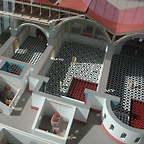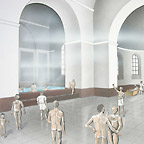Landschaftsverband Rheinland - Qualität für Menschen

LVR-Archäologischer Park Xanten
LVR-RömerMuseum

You are her: Archäologischer Park Xanten > LVR-RömerMuseum > Town Baths > Roman Baths
Roman Baths
The Town Baths were far more than a place for relaxation and personal hygiene. This is where the Romans met with neighbours and friends, exchanged news, cut deals and sometimes also made political decisions. The baths were the city's meeting point and social centre.



Many Romans visited the baths every day.
The bathing wing was the heart of a big complex close to the city centre. Arcades with rows of stores, latrines, a water tower and a huge entrance hall were grouped around a wide courtyard. The complex provided everything the Romans needed to relax body and soul. The new RömerMuseum sits on the foundation walls of the former entrance hall.
The baths were located in big, magnificently decorated rooms. The floors and walls were clad with marble and the pillars and external facade were elaborately designed.

Visitors entering the building through the big hall from the south found themselves in the frigidarium, the cold bath, whose narrow sides were lined with cold water basins for refreshment. Remains of the basins and floors have been preserved.

On either side of the cold bath was a sweating bath. Like today's Finnish saunas, these permitted guests to sweat profusely at high temperatures. The Roman sweating baths were heated by furnaces that were located in adjacent rooms.

Then, bathers reached two big heated halls where they could get a massage or simply relax. Here, too, the remains of the furnaces on the narrow sides have been preserved.

At the far end of the building was the 350 square metre hot bath where the temperatures were very high. It consisted of a large central room with two lateral apsises which probably housed bath tubs.

From antique documents we know that many Romans visited the baths on a daily basis. Usually the baths opened around noon and remained open until dark. A stay at the baths was very diverting. In addition to the diversion provided by other bathers, merchants and food stalls offered a wide range of snacks and goods. Visitors could attend events, play ball games in the courtyard or just chat with friends and acquaintances.

